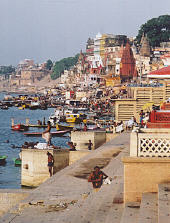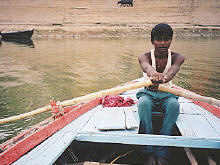Benares is Burning
![]()
![]()
![]()


![]()
![]()
Once again I was above, looking down, perched in safety on a dirty balcony of a hospice overlooking the holy Ganges. Below were four sand pits and boats piled high with large logs of chopped wood. In an alleyway to my left, always below me, I could hear the approach of chanting men as they brought in a body on a bamboo stretcher covered in orange and gold cloths.
Elsewhere men carried a simply wrapped mummy in white to the riverbank and dipped it once in the water of the Ganges. Then it was laid on the steps that lead to the river. Surrounding one of the pits was a group of men and a priest; the priest was pouring ghee, clarified butter, over a body on a pile of logs, the ghee pouring like vegetable oil and then coming out in soft buttery clumps. The priest carried a bunch of sticks held together like a broom and walked around the body five times, encircling it with a fine gold thread of tinsel held by the sticks. More wood was placed on the body so only the sphere of a cloth-wrapped head was distinguishable.
I couldn’t distinguish the lips of the priest. I couldn’t tell if he was saying any final prayers over this person’s soul. Maybe not – according to the Hindus, if you die in Benares then you’re released from the cycle of reincarnation and achieve moksha. At this Manikarnika Ghat, the main burning ghat in Varanasi, moksha was in the air.
![]()
![]()
![]()


![]()
![]()
The priest lit small fires around the body and as it took to flame a boy was nudging me in the ribs asking if I wanted body stamps or postcards, a crippled woman came and asked for money for those at the hospice who came here to die, Hindi film music played somewhere behind me and a cock was crowing.
Life is lived out in the open here, and death plays her game every moment of the day. Only I am left standing on a balcony inhaling smoke that is sometimes sweet, sometimes just smoky, and find that I am covered in white snowflakes of ash.
There are snowflakes in my hair, gritty ashes between my teeth.